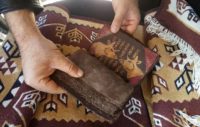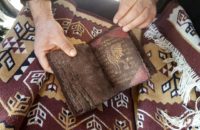 Turkish police have seized a leather manuscript believed to have been looted from Syria in an anti-smuggling operation in Kırşehir, central Turkey. Two individuals identified only as Erkan Ş. and Kısmet G. were stopped by the Kırşehir Police Department Anti-Smuggling and Organized Crime and Anti-Narcotics Department while driving on the Ankara-Kayseri highway. Stashed on the side of the seat wrapped in a blanket was the 12-page volume. The suspects were arrested and charged with antiquities trafficking.
Turkish police have seized a leather manuscript believed to have been looted from Syria in an anti-smuggling operation in Kırşehir, central Turkey. Two individuals identified only as Erkan Ş. and Kısmet G. were stopped by the Kırşehir Police Department Anti-Smuggling and Organized Crime and Anti-Narcotics Department while driving on the Ankara-Kayseri highway. Stashed on the side of the seat wrapped in a blanket was the 12-page volume. The suspects were arrested and charged with antiquities trafficking.
According to suspects’ testimonies to the police, they bought the manuscript in the southeastern Mardin province and were planning to sell it in Istanbul for a large sum of money.
The manuscript was stolen from a museum in Syria during the conflict and was brought to Mardin illegally, the suspects said in their testimonies.
That’s all the information reported so far, which is barely any information at all. It’s only post-worthy because of the illuminations.
 The manuscript is 16 pages long and is written in Hebrew in gold ink. The cover has metallic accents: four birds, one in each corner, on circular perches and a Star of David with a red stone in the center hexagon in the middle of the page. Most of the sheets are illuminated with an intriguing variety of images, including a dragon or griffin, two cows looking at each other challengingly, a hamsa hand, a menorah, a Star of David, an owl with a skull on its belly and a man in draped robes.
The manuscript is 16 pages long and is written in Hebrew in gold ink. The cover has metallic accents: four birds, one in each corner, on circular perches and a Star of David with a red stone in the center hexagon in the middle of the page. Most of the sheets are illuminated with an intriguing variety of images, including a dragon or griffin, two cows looking at each other challengingly, a hamsa hand, a menorah, a Star of David, an owl with a skull on its belly and a man in draped robes.
\begin shamelessly speculative romp
 I find the iconography fascinating. The owl with a skull on its belly and the man in draped robes are particularly intriguing. The owl is listed among the abomination birds in Leviticus and in medieval Christendom it was often used to symbolize Jews as creatures of darkness because of their rejection of Christ. As for the man, the prohibition against graven images put a damper on figural depictions in Jewish art, but it didn’t prevent it entirely. There are frescoes, mosaics and manuscripts with images of Biblical figures, even ones from pagan mythology employed as metaphors. He could be a representation of a prophet or anybody else, for that matter. He does bear a resemblance to other rough drawn images of Jesus, however.
I find the iconography fascinating. The owl with a skull on its belly and the man in draped robes are particularly intriguing. The owl is listed among the abomination birds in Leviticus and in medieval Christendom it was often used to symbolize Jews as creatures of darkness because of their rejection of Christ. As for the man, the prohibition against graven images put a damper on figural depictions in Jewish art, but it didn’t prevent it entirely. There are frescoes, mosaics and manuscripts with images of Biblical figures, even ones from pagan mythology employed as metaphors. He could be a representation of a prophet or anybody else, for that matter. He does bear a resemblance to other rough drawn images of Jesus, however.
 If it is meant to be Christ, he and the skull-bellied owl share the volume with unambiguous symbols of Judaism, the Star of David and the menorah, and the hamsa hand, a symbol very common in albeit not exclusive to Judaism. Not that I’m any kind of expert, or even a well-informed amateur, but I wonder if this be an artifact from one of the Jewish Christian communities that are known to have been in Syria in late antiquity and the early Middle Ages, like the Ebionites or Nazarenes.
If it is meant to be Christ, he and the skull-bellied owl share the volume with unambiguous symbols of Judaism, the Star of David and the menorah, and the hamsa hand, a symbol very common in albeit not exclusive to Judaism. Not that I’m any kind of expert, or even a well-informed amateur, but I wonder if this be an artifact from one of the Jewish Christian communities that are known to have been in Syria in late antiquity and the early Middle Ages, like the Ebionites or Nazarenes.
\end shamelessly speculative romp
The manuscript has been transferred to the Kırşehir Museum Directorate which will study it and determine its origins. Here’s hoping the findings are released.


Fascinating.
It looks like a particularly bad movie prop.
Looks to me like a book of spells. It is not written in modern Hebrew although the letters are. Could be Aramaic or…….
Whatever it is it is interesting
Always enjoy your blog reporting and great imagery!
This item, I hate to feel so skeptical…
Two things really ping my ‘???’ meter.
That is an awfully well faceted and clear stone on front cover for the proposed time period.
Oh-wait- I was totally thinking gem mineral! It could be glass! Was that doable then?
The color is painted on?~ note the color is on edges of the ‘metal’parts.
Truly DO look forward to the findings!
Sixteen loabs of leaflet leather? –Are they ‘kosher’?
In case they would be, what exactly do they say, and what conclusions may be derived from how it is said? The ‘Codex Argenteus’ had been written with gold and silver ink on high-quality thin purple parchment vellum. Thus, I wonder if our pages here are considerably younger.
My own -completely uneducated- guess, therefore, would be that we are dealing here with ‘prescriptions on how to prepare leather sheets’ (either 200 or 20 years old). –Susie seems to have a point, though.
:hattip:
———————-
P.S.: “…Kujau says he began to forge the first volume of his ‘Hitler Diaries’ in 1978. He used one of a pile of notebooks he had bought cheaply in East Berlin, and put the letters AH in gold on the front, although these letters were purchased in a department store, made of plastic in Hong Kong, and he used –in Old English font– ‘FH’, rather than AH .” [“…and his name was not precisely FRITZ(!) Hitler, was it?!?” (from “Schtonk!”,1992)]
Lots of these ‘Golden Brownies’ have been turning up on the market over the past few years (none from reliable sources). Despite the self-congratulatory publicity of the Turkish police at having brilliantly cracked a Syrian smuggling ring, most scholars regard these garish items as no more than fake tat aimed at gullible buyers.
They all have certain characteristics:
http://paul-barford.blogspot.com/2019/02/the-golden-brownies-turkish-fake.html
It looks like a brand new prop of a schoolplay.
It is a nice object, but I also think this could be a fake. Look at the central ‘thing’ hole: it is larger than the upper and lower ones, and yet is the one least prone to wear: I mean, how many old books have you seen fall apart from the center of the spine, as opposed to either end of the spine?
Honestly, this thing is so fake it’s not worthy of your blog.